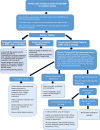Newborn screening for Duchenne muscular dystrophy-early detection and diagnostic algorithm for female carriers of Duchenne muscular dystrophy
- PMID: 36152336
- PMCID: PMC9826042
- DOI: 10.1002/ajmg.c.32000
Newborn screening for Duchenne muscular dystrophy-early detection and diagnostic algorithm for female carriers of Duchenne muscular dystrophy
Abstract
Duchenne muscular dystrophy (DMD) is the most common pediatric-onset form of muscular dystrophy, occurring in 1 in 5,000 live male births. DMD is a multi-system disease resulting in muscle weakness with progressive deterioration of skeletal, heart, and smooth muscle, and learning disabilities. Pathogenic/likely pathogenic (P/LP) variants in the DMD gene, which encodes dystrophin protein, cause dystrophinopathy. All males with a P/LP variant in the X-linked DMD gene are expected to be affected. Two to 20% of female heterozygotes with a P/LP variant develop symptoms of dystrophinopathy ranging from mild muscle weakness to significant disability similar to Becker muscular dystrophy. Recently, with improvements in therapies and testing methodology, there is stronger evidence supporting newborn screening (NBS) for DMD for males and females because females may also develop symptoms. A consented pilot study to screen newborns for DMD was initiated in New York State (NYS) and conducted from 2019 to 2021. The identification of female carriers and the realization of the subsequent uncertainty of providers concerning follow-up during the pilot led to the development of algorithms for screening and diagnosis of carrier females, including both NBS and cascade molecular testing of family members.
Keywords: duchenne muscular dystrophy; dystrophinopathy; female carrier; newborn screening.
© 2022 The Authors. American Journal of Medical Genetics Part C: Seminars in Medical Genetics published by Wiley Periodicals LLC.
Figures
References
-
- American Academy of Pediatrics Section on Cardiology and Cardiac Surgery . (2005). Cardiovascular health supervision for individuals affected by Duchenne or Becker muscular dystrophy. Pediatrics, 116, 1569–1573. - PubMed
-
- Apkon, S. , Kinnett, K. , Cripe, L. , Duan, D. , Jackson, J. L. , Kornegay, J. N. , … Flanigan, K. M. (2021). Parent Project Muscular Dystrophy females with Dystrophinopathy conference, Orlando, Florida June 26–June 27, 2019. Journal of Neuromuscular Diseases, 8(2), 315–322. 10.3233/JND-200555 PMID: 33361607. - DOI - PMC - PubMed
-
- Bushby, K. , Muntoni, F. , & Bourke, J. P. (2002). 107th ENMC international workshop: The management of cardiac involvement in muscular dystrophy and myotonic dystrophy. 7th‐9th June 2002, Naarden, The Netherlands. Neuromuscular Disorders, 2003(13), 166–172. - PubMed
Publication types
MeSH terms
Substances
LinkOut - more resources
Full Text Sources
Research Materials
Miscellaneous



